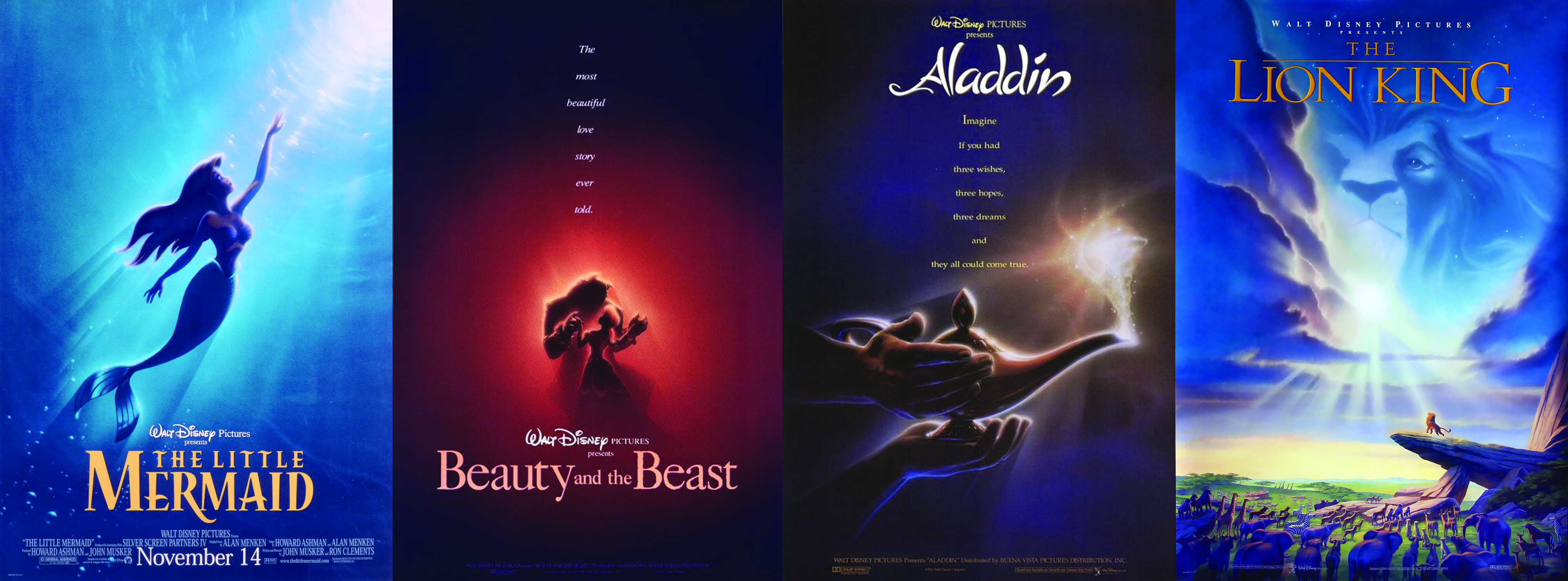In Marina Warner’s short history of the fairy tale book, Once Upon A Time, she posits that one of the primary functions of the fairy tale is the sharing of familiar stories with an audience. She goes on to explain “the stories’ interest isn’t exhausted by repetition, reformulation, or retelling, but their pleasure gains from the endless permutations performed on the nucleus of the tale, the DNA as it were.” While fairy tales have a long history of corporate usage, it is during the 1990s that the very DNA and nuclei of fairy tales became increasingly co-opted by media companies, by Disney in particular. Disney wasn’t just using the Little Mermaid to sell shampoo, they were attempting to establish their version of the Little Mermaid to the public as the definitive take on the tale.
Again, Disney had commercialized popular fairy tale figures before, but the 1990s was a unique decade of interrupted commercial and critical success. This decade has been described as the Disney Renaissance, a span of years where the studio released 10 animated films including The Little Mermaid (1989), Beauty and the Beast (1991), Aladdin (1992), The Lion King (1994), and others.
During this decade, advertisers relying on fairy tale figures had to differentiate themselves stylistically from the Disney versions of the tales, both to establish their own unique place to sell products and presumably to avoid any legal action from the House of Mouse. So, while Disney’s fairy tale figures were showing up unceremoniously in McDonald’s Happy Meal commercials, other brands had to find new ways to exploit fairy tale iconography.
In the Oxford Companion to Fairy Tales, Jack Zypes explains “fairy tales are well suited to television commercials because they are popular and easily recognized. Their familiar motifs can be truncated and adapted for brief commercials while still remaining meaningful.” A perfect example of this truncated style of storytelling can be seen in a 1999 Ford commercial featuring the Three Little Pigs.
This story is told without narration or dialogue, instead relying entirely on familiar iconography and recognizable animation styles. The only narration comes at the end: simple ad copy naming the product and connecting it to the tale with a quick pun. Ford responded to the Disney takeover by featuring Looney Tunes and Sesame Street characters in their commercials for their latest Windstar minivans, a halfhearted attempt to set themselves apart.
A 1997 Honey Nut Cheerios commercial uses a truncated version of the Little Red Ridding Hood story, starting right in the middle of the familiar story without explanation, assuming audience familiarity with the tale. The story is quickly and literally interrupted by a corporate mascot.
It is notable that even in this ad featuring lighthearted music, that also presents the wolf as an amusing if not comedic character, it still ends with an ominous reminder that the wolf ate Red’s grandmother. The dark nucleus of Red’s story survives, even as BuzzBee’s rattles off the superlative qualities of Honey Nut Cheerios.
One of the more interesting fairy tale-adjacent commercials of this decade comes from Levis. The commercial opens with an image of a clock striking midnight and cuts next to the image of a woman running down stairs, leaving behind a shoe. The iconography is unmistakable and immediately recognizable as a Cinderella story.
After the first 7 or 8 seconds of these kinds of traditional establishing shots, the story starts to take unfamiliar turns. The prince charming figure chasing after the Cinderella stand-in is scared away by another man on a motorcycle. The motorcycle man leaves behind an article of clothing as he quickly exists, leaving Cinderella to pick up the pair of jeans and begin her search for this illusive man. The commercial digs into this subversive gender-swapped narrative, empowering Cinderella with active agency as she looks for her perfect match. The men are increasingly objectified to the point where when we finally see the motorcycle man again he is shirtless, sweaty, and shot in slow motion.
This Levis ad succeeds where so many other commercials featuring fairy tale iconography have stopped short. It knowingly comments on the tropes of fairy tale and updates them with modern sensibilities all while artfully remaining true to the DNA of Cinderella’s story. And if that wasn’t enough it does all of this with artistic and imaginative shots and edits while additionally relying on depictions completely separate from the corporate-owned versions permeating the culture of the time. Would that all fairy tale commercials were this innovative.

